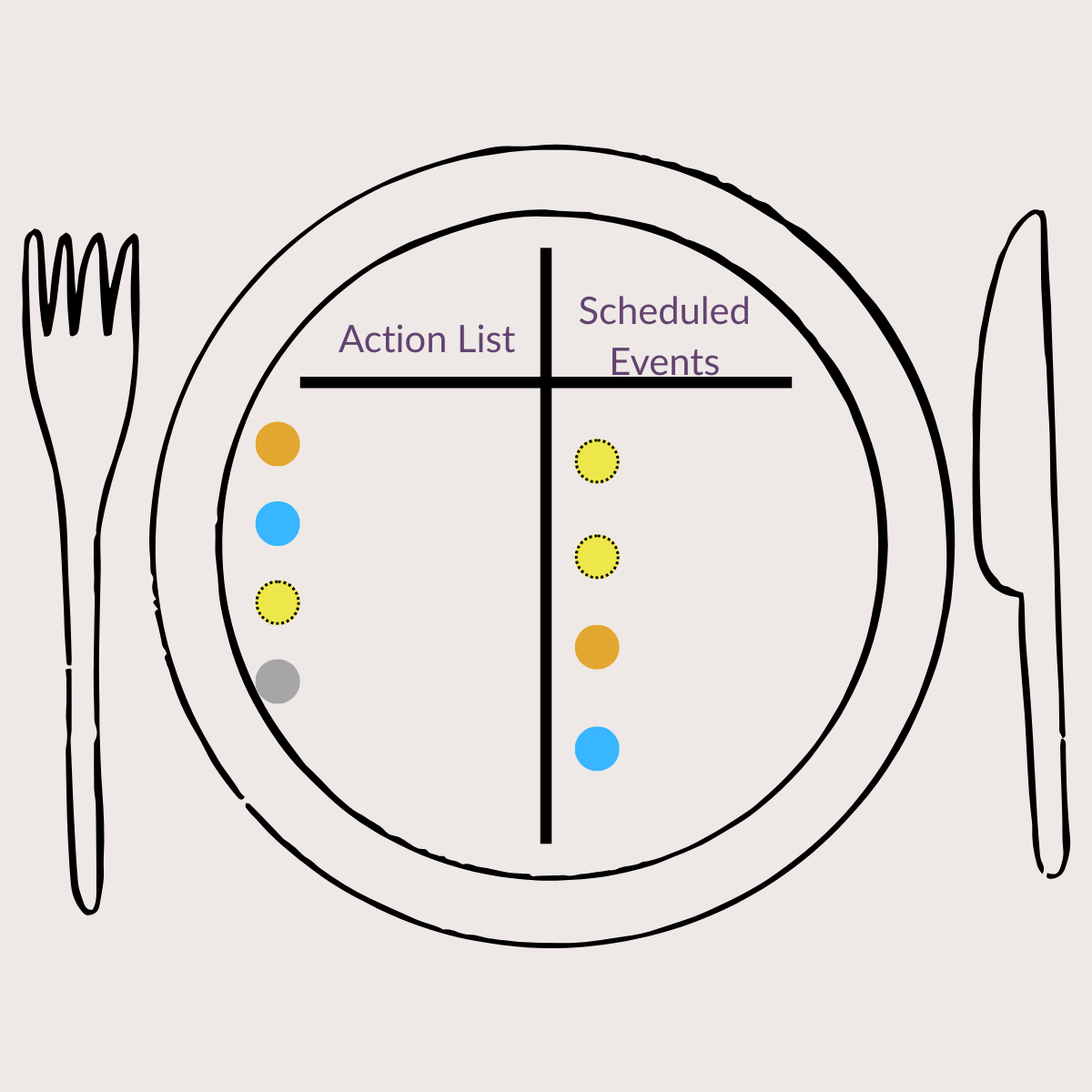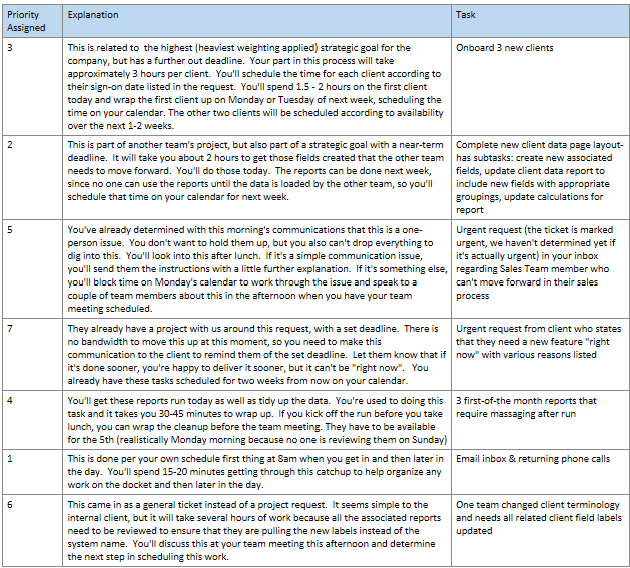Prioritization Example

Good Friday morning!
While I do my best to get the Newsletter out on Thursdays, sometimes I have to make exceptions. We had a small family emergency yesterday that took me from the office and it's OK. My family comes first - they are my highest priority - and they will always override anything else on my plate. And since this is a message about prioritization, it's probably important to note that a) everyone will have a personal priority that takes precedence over any work item b) what that is will relate to your values that we talked about earlier this year (2-3 episodes ago, I think?).
So, Thursday Thoughts - I absolutely thought about this episode on Thursday, therefore it still counts and the name still stands 😁. After last week's discussion on prioritization, I had a few requests to see an actual list prioritized with a little more nitty gritty. Why not?! Before we start, I have to say that trying to come up with a fake list of work to prioritize is actually harder than working on a real list. (If anyone wants help with an actual list, book time and I'll give you a quick run-down.) I also have to say that...just because you prioritize something on paper, it doesn't mean you've actually prioritized it. There are some tasks that you just. don't. want. to. do. PERIOD. And you will have to hard block time on your calendar, get a coffee, and maybe take a walk around the block before you do it. It's OK! We're all human and we all have these struggles. We're just going to keep doing the best we can. Alright, enough of my rambling, let's dig in.
How do we do this?! Let's look at a logical approach to prioritization when everything feels important
When your to-do list looks like a wall of noise:
A project deadline looming in the near distance.
A manager or client pinging with an urgent request.
Something broke overnight and now you have a bug-fix.
Emails piling up by the minute.
A handful of “quick tasks” that never feel quick.
It’s overwhelming — and without a plan, we default to reacting instead of pro-acting. That’s where prioritization comes in.
Prioritization isn’t about doing everything at once or chasing the loudest voice. It’s about aligning your work with strategy, deadlines, and impact. As we discussed last week, prioritization done well not only reduces stress — it actually makes you a stronger performer AND leader because you model clarity, calm, and discipline for your team.
So, let's walk through step-by-step how to prioritize when everything feels urgent.
The uncounted first step? Take a breath. Give yourself some good self-talk: I can do this, I always manage my work well, this load isn't anything I haven't seen before, I just need to make a quick plan. Why do I say this? You can be your biggest cheerleader or naysayer. It's better to be the former. Be on your own side!
The list we'll work from -
Onboard 3 new clients
Complete new client data page layout- has subtasks: create new associated fields, update client data report to include new fields with appropriate groupings, update calculations for report
Urgent request (the ticket is marked urgent, we haven't determined yet if it's actually urgent) in your inbox regarding Sales Team member who can't move forward in their sales process
Urgent request from client who states that they need a new feature "right now" with various reasons listed
3 first-of-the month reports that require massaging after run
Email inbox
One team changed client terminology and needs all related client field labels updated
Step 1: Anchor to Strategic Goals
Before you touch the list, zoom out. We need to approach this list from the Big Picture View! Ask:
Does this task directly connect to a strategic goal? (You should have a readily accessible list of current corporate strategies. If not... seek this out!)
If I didn’t do this today, would progress toward our big objectives stall?
For our example list: our company has a Q4 goal of onboarding five new clients, project work tied to onboarding takes precedence over random “nice-to-have” requests. Strategic alignment always comes first — it’s the north star. The deadline for completion is December 15th.
Step 2: Check Deadlines and Dependencies
Deadlines matter — but not all deadlines are equal.
Hard deadlines (regulatory filings, client deliverables, launch dates) are non-negotiable.
Soft deadlines (internal milestones, status updates) can sometimes flex if reprioritized thoughtfully.
Dependencies the project isn't owned / led by your team, but your team has a part to play in order for another team to meet their goals, which may be tied to corporate strategy. Dependencies add another layer of complexity: Based on the aforementioned explanation - if someone else’s work is blocked until you finish, bump that task higher. Helping the whole system flow often beats pushing through on something that only affects you.
For our example list:
***Another team in your Division has a project to update the client portal. They have data that has been collected by both Sales & Client Support manually and they need to feed it into the backend system that your team manages in order to display pieces back to the client. Their project aligns with our company's strategic goal of improving access to data by the Clients. Their project due date is October 18th and they are pending the new field names from your team.
***First of the month reports are due by the 5th of the month every month.
Step 3: Triage the “Urgent” Requests
Urgent doesn’t always mean important. When a last-minute request comes in, run it through two filters:
Does it connect to our strategy? If yes, elevate it.
Does it prevent client risk or loss? (Think: a bug breaking a customer’s access.) Those belong high on the list, even if unplanned.
Does it prevent team(s) from working? Even if the problem is internal only, if it prevents large numbers of people from working, this needs to be elevated. You should have a threshold set internally regarding what constitutes a "sev 1" issue. If you don't, it's time to sort that out, so that everyone has a better idea of how work should be prioritized.
This filter protects you from letting every loud request derail the real priorities.
For our example list: You message the submitter of the urgent request for the single Sales User. You confirm that the problem is only with that individual. You let them know that you are changing the priority from urgent to standard response time and you will get back to them within 3 business days. They'll probably push back because it's important to THEM. You refer them to the standards of support that state that a 1 person issue does not warrant an Urgent assignment and that you have to work tickets based on the rules set for you. (You'll probably sort this out sooner than that, but you need to set the expectation. You already know that this is probably because they aren't completing a specific step, but need to confirm in the system.)
Step 4: Manage Bug Fixes and Break/Fix Issues
Bugs are tricky because they demand speed — but not every bug is mission-critical. This is closely related to the above item and these two categories will often bleed into each other. Sometimes items are just marked URGENT. Sometimes items are marked as critical bugs. Usually we have to do a little investigation to figure out which is which.
Critical bugs (system down, customers impacted) jump to the top immediately.
Low-impact bugs (minor display issues, internal tools with workarounds) should be scheduled into planned work, not handled reactively.
This distinction keeps you from letting “fixes” consume the day at the expense of strategic progress.
For our example list: Nothing on the list currently appears to be a critical bug fix. If there were any, they would need to be scheduled at the top of the list. There are also no Low-impact bugs.
Step 5: Batch Small Tasks and Email
Here’s where people lose hours without realizing it: small tasks and email. Individually, they look harmless. Collectively, they eat your focus.
Instead of sprinkling them throughout the day, batch them into dedicated windows:
Clear emails at set times (e.g., twice a day). This is a hard one to acclimate to because we have a natural tendency to be nervous about missing something. In most email systems, you can set flags for important email. You might be also to set these to alert you in another way. Put this to use if possible, so that you don't miss urgent issues. ALSO - remind folks that urgent issues should be communicated via a text / instant message / phone call per whatever rules you have set in place to communicate urgent issues. If we're doing action-based work, we're not in email. If we're in email, we're doing communication work, we're not doing action-based work. It's a balance.
Group similar small tasks and knock them out in one sitting. I.e. - running reports, logging project work updates, submitting expenses.
This prevents context-switching and preserves energy for bigger, higher-impact work.
For our example list: You process your email / instant messages pending / phone calls as soon as you get in, just before lunch, and around 2pm every day. If you end up with a few minutes, you'll clear them before you leave your desk at the end of the day. This is why you've already chatted about the urgent ticket and found out that the problem is JUST related to them - in addition to the ticket, they also sent you an instant message.
Step 6: Layer It All Together (The Daily Flow)
Once you’ve sorted by strategy, deadlines, urgency, bugs, and batching, your day might look like this:
Address any true urgent/critical items (bug fix, client-blocking task).
Move on with 1–2 high-impact project tasks tied to strategic goals.
Tackle dependent tasks so others can keep moving.
Schedule your batching blocks for email and small tasks later in the day.
This flow ensures you move the big rocks first, without ignoring real fires or letting the small stuff dominate.
Step 7: Re-Evaluate as Needed
Prioritization isn’t a one-and-done activity. Things change. At mid-day, take 5 minutes to check in, so that you can reorganize your afternoon if necessary:
Did something critical come up?
Do I need to swap the order?
Am I still aligned to strategy?
A flexible system beats a rigid one — as long as it’s grounded in strategic clarity.
Based on everything we've gone through, this is the priority I've set for our example list:

The Payoff of Sticking to Priorities
When you prioritize with intention:
Your team sees that you don’t just react — you're proactive.
The “urgent” no longer derails the important.
Strategic goals actually get delivered.
It’s not about saying yes to everything — it’s about saying yes to the right things.
What's Next?
If your team struggles with prioritization, chaos isn’t inevitable. I help leaders cut through the noise, align to strategy, and get projects moving again.
👉 Ready to bring clarity to your workday (and your team’s)? Let’s talk.
Created with © systeme.io


